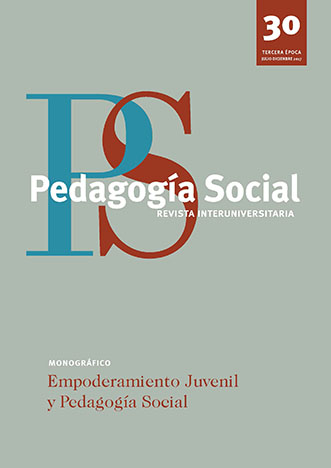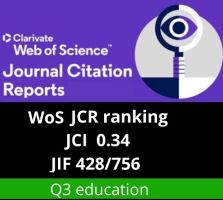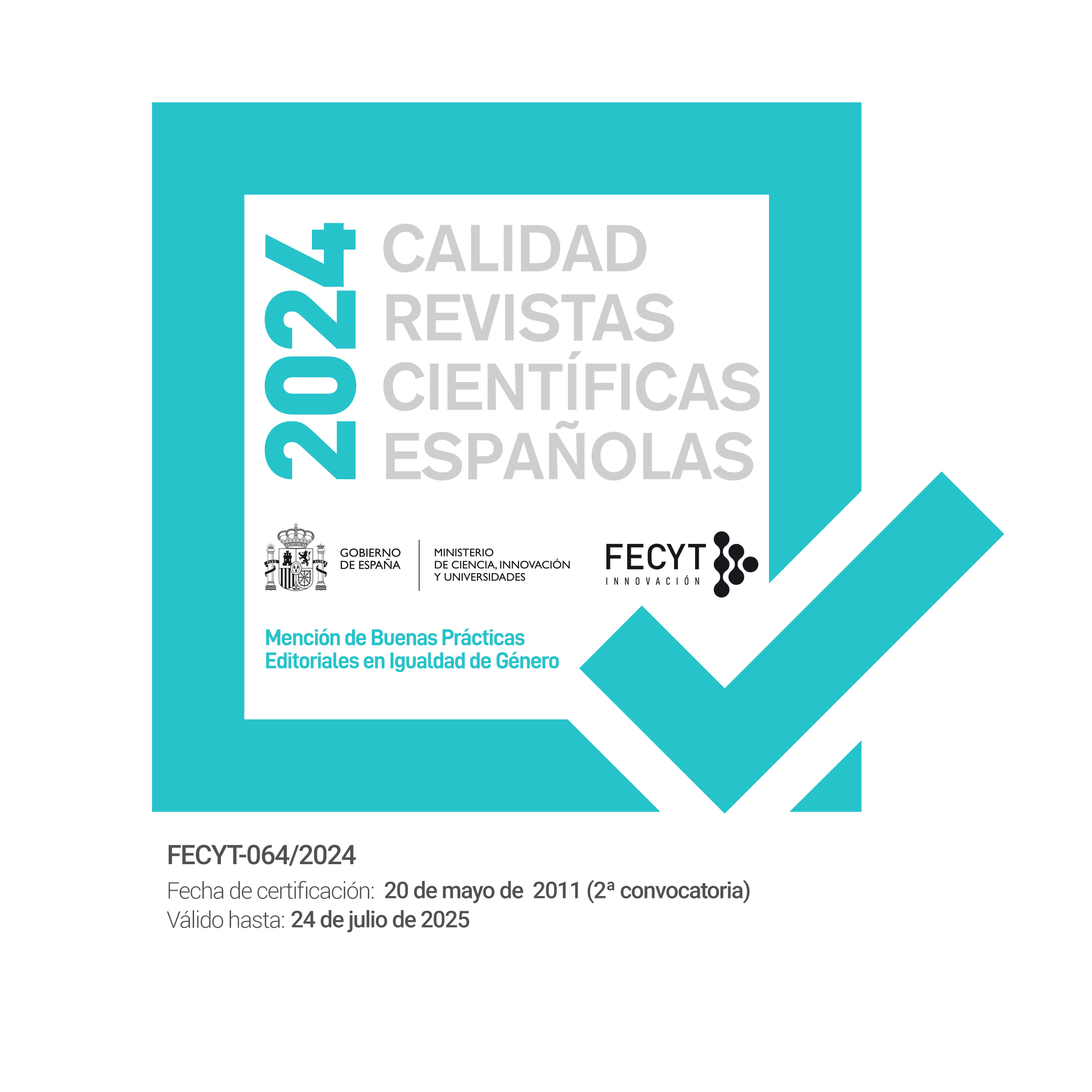El género del documental interactivo como experiencia artística-creativa de empoderamiento juvenil: el caso del Webdoc HEBE
DOI:
https://doi.org/10.7179/PSRI_2017.30.07Palabras clave:
Empoderamiento, Juventud, Webdoc, pedagogía artística, ciencia ciudadanaResumen
Las posibilidades de interacción que ofrecen las nuevas tecnologías abren posibilidades inéditas tanto para la investigación del empoderamiento juvenil en el seno de la academia, como para el el diseño e implementación de metodologías participativas que favorezcan los procesos de empoderamiento de los jóvenes en la sociedad. El webdoc HEBE [www.hebewebdoc.com] que describimos en este artículo se presenta como un caso pionero en el terreno del empoderamiento juvenil por el hecho de aunar en una única plataforma interactiva relatos de empoderamiento concebidos como piezas audiovisuales, reflexiones sobre el proceso de creación a través de distintos focus group y, finalmente, la posibilidad de compartir digitalmente estos materiales audiovisuales para hacerlos dialogar con la ciudadanía. En la primera parte del artículo se detallan y analizan los tres factores principales que están en la base del webdoc HEBE: la evolución de las metodologías participativas de empoderamiento basadas en la creación audiovisual, la utilización de nuevos soportes transmediáticos que permiten la participación colectiva y, por último, la consolidación de una pedagogía del cine como vía de aprendizaje de una experiencia vital y emocional. En la segunda parte se detallan las fases del proceso de construcción del webdoc HEBE, profundizando en los aspectos más relevantes y exponiendo sus cualidades como herramienta de ciencia ciudadana. También se explica la metodología pedagógica aplicada en el taller de creación y el diseño de la página de navegación del webdoc que implica la construcción de narrativas que permitan al usuario reflexionar sobre los procesos, espacios y momentos de empoderamiento juvenil. Finalmente, en la tercera parte, se presentan los primeros resultados derivados de la finalización del diseño del webdoc como plataforma, a partir del análisis de las piezas resultantes, realizadas por los participantes del taller de pedagogía audiovisual.
Descargas
Citas
Aidelman, N., & Colell, L. (2014). Elogio del amor. Cine en curso. Cinema Comparat/ive Cinema. vol. 2, n. 5, 24-30.
Bergala, A. (2007). La hipótesis del cine. Pequeño tratado sobre la transmisión del cine. Barcelona: Laertes.
Bergala, A. (2014). Compartir los gestos de creación. Cinema Comparat/ive Cinema. vol. 2, n. 5, 12-17.
Betancor, M. (2011). “Empoderamiento: ¿una alternativa emancipatoria? Reflexiones para una aproximación crítica a la noción de empoderamiento”. Revista Margen 61.
Casacuberta, D. (2009). Creación colectiva. En internet el creador es el público. Barcelona: Gedisa.Català, J. M. (2010). La necesaria impureza del nuevo documental. Líbero, vol. 13, n. 25. Brasil: Sao Paulo, 45-56.
Cohen, A.E. (2016). Investigación evaluativa para el diseño de una propuesta de intervención en edu-comunicación para la ciudadanía activa: análisis de los proyectos La Cruïlla Comuna y Desmuntamites. Barcelona: Tesis doctoral dirigida por la Dra. Mónica Figueras y presentada en la UPF.
Comolli, J. (2007). Ver y poder. La inocencia perdida: cine, televisión, ficción, documental. Buenos Aires: Nueva Librería.
Delgado, M. (2015). Urban Youth and Photovoice. Oxford: Oxford University Press.
Finholdt, N., Michael, Y., & Davis, M. (2010). Photovoice engages rural youth in childhood obesity prevention. Public Health Nursing, vol. 28, 186-192.
Fortunati, L. (2014). Media Between Power and Empowerment: Can We Resolve This Dilemma? The Information Society. 30 (3), 169-183.
Foster-Fishman, P., Law, K., Lichty, L., & Aoun, C. (2010). Youth ReACT for social change: A method for youth participatory action research. Journal of Community Psychology, vol. 46, 67-83.
Gifreu, A. (2014). El documental interactivo como nuevo género audiovisual. Evolución, caracterización y perspectivas de desarrollo. Barcelona: UOC Press.
Haynes, K., & Tanner, T. (2013). Empowering young people and strengthening resilience: youth-centred participatory video as a tool for climate change adaptation and disaster risk reduction. Children’s Geographies, vol. 13, 357-371. DOI: 10.1080/14733285.2013.848599.
Irwin, A. (1995). Citizen science. A Study of People, Expertise and Sustainable Development. Nueva York: Routledge.
Ito, M. et al. (2010) Hanging Out, Messing Around, and Geeking Out. Kids Living and Learning with New Media. Cambridge (Massachusetts): The MIT Press.
Jenkins, H. (1992). Textual Poachers. Television Fans & Participatory Culture. Nueva York: Routledge.
Jenkins, H., Ito, M., & boyd, d. (2016). Participatory Culture in a Networked Era. Malden (USA): Polity Press.
Langlois, H. (1986). Henri Langlois. Trois cent ans de cinéma. Écrits. París: Cahiers du cinéma, Cinémathèque Française, FEMIS, pp. 96-99.
Lawrencejacobson, A. R. (2006). Intergenerational Community Action and Youth Empowerment. Journal of Intergenerational Relationships, 4 (1), 137-147.
Lloret, N., & Canet, F. (2008) Nuevos escenarios, nuevas formas de expresión narrativa: La Web 2.0 y el lenguaje audiovisual. Hipertext.net, 6. En http://www.hipertext.net Última consulta: 26 de febrero de 2017.
Nichols, B. (1991). La representación de la realidad. Cuestiones y conceptos sobre el documental, Barcelona, Paidós.
Martin Gutiérrez, G. (Coord.) (2008). Cineastas frente al espejo, Madrid: T&B Editores, pp. 35 52.
Ohmer, M., & Owens, J. (2013). Using Photovoice to Empower Youth and Adults to Prevent Crime. Journal of Community Practice, v. 21, issue 4, 410-433.
Pritzker, S., LaChapelle, A., & Tatum, J. (2012). Urban Youth and Photovoice: Visual Ethnography in Action. Oxford: Oxford University Press.
Reips, U., & Bosnjak, M. (2011). Dimensions of Internet Science. Lengerich (Alemania): Pabst Science Publishers.
Reflect-Action (2009). Reflect. Recuperado de http://www.reflect-action.org/es/home Última consulta: 26 de febrero de 2017.
Reza, M. (2013). Obreros Trabajando: Lecciones Cinematográficas de Abbas Kiarostami. Mhughes Press.
Russell, S. T., Muraco, A., Subramaniam, A., & Laub, C. (2009). Youth empowerment and high school gay-straight alliances. Journal of youth and adolescence, 38, 891-903. doi:10.1007/s10964-008-9382-8
Scolari, C. A. (2013). Narrativas Transmedia: cuando todos los medios cuentan. Barcelona: Deusto Ediciones.
Sora, C. (2015). Etapas, factores de transformación y modelo de análisis del nuevo audiovisual interactivo online. El profesional de la información, 24 (4), 424-431. doi: 10.3145/epi.2015.jul.09
Soler, P, Trilla, J., Úcar, X., & Jiménez-Morales, M. (2017). La construcción de un modelo pedagógico del empoderamiento juvenil: espacios, momentos y procesos. Pedagogía Social. Revista Interuniversitaria, vol. 30.
Strack, R., Magill, C., & McDonagh, K. (2004). Engaging youth through Photovoice. Health Promotion Practice, vol. 5, 49-58.
Streng, J.M., Rhodes, S., Ayala, G., Eng, E., Arceo, R. & Phipps, S. (2004). Realidad Latina: Latino adolescents, their school, and a university use Photovoice to examine and address the influence of immigration. Journal of Interprofessional Care, 18 (4), 403-415.
Tromp, M. (2007). A system of empowerment indicators for a corporate work environment. Johannesburg: University of Johannesburg. En http://152.106.6.200/handle/10210/737. Última consulta: 26 de febrero de 2017.
Van der Keuken, J. (2001). The Lucid Eye: The Photographic Work 1953-2000. Amsterdam: De Verbeelding.
Wagg, H. (2004). Empowering Youth With Radio Power: “Anything Goes” on CKUT Campus-Community Radio. Journal of Radio Studies, vol. 11:2, 268-276. doi: 10.1207/s15506843jrs1102_11.
Wang, C., & Burris, M.A. (1997). Photovoice. Concept, methodology, and use for participatory needs assessment. Health Education & Behavior, 24, 369-387.
Wang, C. (2006). Youth participation in photovoice as a strategy for community change. Journal of Community Practice, 14 (1-2), 147-161. doi:10.1300/J125v14n01_09.
Wang, C., Morrel-Samuels, S., Hutchison, P. M., Bell, L. & Pestrong, R. M. (2004). Flint Photovoice: Community building among youths, adults, and policymakers. American Journal of Public Health, vol. 94, 911-913.
Wilson, N., Dasho, S., Martin, A., Wallerstein, N., Wang, C., & Minkler, M. (2007) Engaging young adolescents in social action through Photovoice: The Youth Empowerment Strategies (YES!) Project. Journal of Early Adolescence, vol. 27, 241-261.
Wong, N. (2008). A participatory youth empowerment model and qualitative analysis of student voices on power and violence prevention. A dissertation submitted in partial fulfillment of the requirements for the degree of Doctor of Philosophy (Health Behavior and Health Education). Michigan: University of Michigan. Retrieved from http://goo.gl/ yZLBrw. Last visit: 26th February 2017.
Descargas
Archivos adicionales
Publicado
Cómo citar
Número
Sección
Licencia
Derechos de autor 2017 Pedagogía Social. Revista Interuniversitaria

Esta obra está bajo una licencia internacional Creative Commons Atribución-NoComercial-CompartirIgual 4.0.
Derechos de reproducción y archivo
La versión publicada de los artículos podrá ser autoarchivada por sus autores en repositorios institucionales y temáticos de acceso abierto. No obstante la reutilización total o parcial de los mismos en nuevos trabajos o publicaciones deberá ser autorizada por Pedagogía Social. Revista Interuniversitaria.
Los trabajos publicados deberán ser citados incluyendo el título de la Revista, Pedagogía Social. Revista Interuniversitaria, nº, páginas y año de publicación.
Responsabilidades éticas
Pedagogía Social. Revista Interuniversitaria no acepta material publicado anteriormente en otros documentos. Los/as autores/as son responsables de obtener los permisos oportunos para reproducir parcialmente material de otras publicaciones y citar correctamente su procedencia. Estos permisos deben solicitarse tanto al autor/a como a la editorial que ha publicado dicho material.
Es obligación de Pedagogía Social. Revista Interuniversitaria detectar y denunciar prácticas fraudulentas.
En la lista de autores/as firmantes deben figurar únicamente aquellas personas que han contribuido intelectualmente al desarrollo del trabajo.
La revista espera que los/as autores/as declaren cualquier asociación comercial que pueda suponer un conflicto de intereses en conexión con el artículo remitido.
Los autores deben mencionar en el manuscrito, preferentemente en el apartado del método, que los procedimientos utilizados en los muestreos y controles han sido realizados tras la obtención de consentimiento informado.
La revista no utilizará ninguno de los trabajos recibidos con otro fin que no sea el de los objetivos descritos en estas normas.
Aviso de derechos de autor/a
© Pedagogía Social. Revista Interuniversitaria. Los originales publicados en las ediciones impresa y electrónica de esta Revista son propiedad del Pedagogía Social. Revista Interuniversitaria, siendo necesario citar la procedencia en cualquier reproducción parcial o total.
Salvo indicación contraria, todos los contenidos de la edición electrónica se distribuyen bajo una licencia de uso y distribución “Creative Commons Reconocimiento-No Comercial 3.0 España” (CC-by-nc). Puede consultar desde aquí la versión informativa y el texto legal de la licencia. Esta circunstancia ha de hacerse constar expresamente de esta forma cuando sea necesario.






